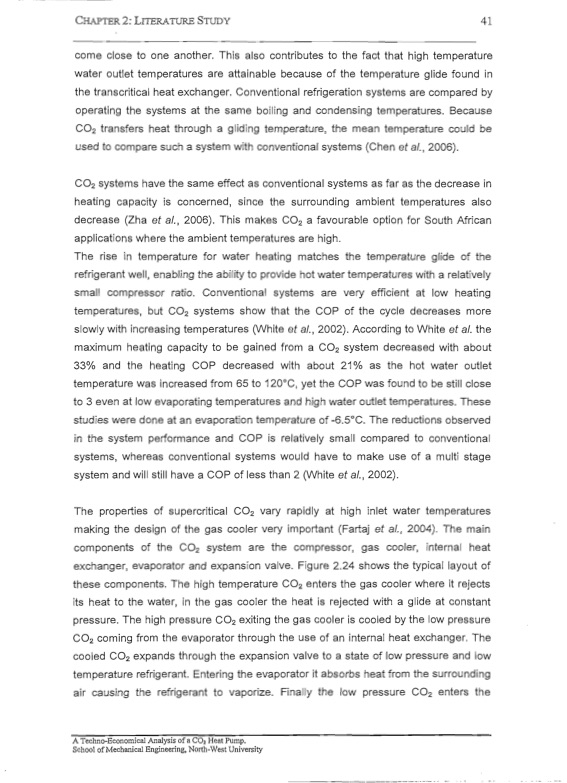
PDF Publication Title:
Text from PDF Page: 053
CHAPTER 2: LITERA TURE STUDY 41 come close to one another. This also contributes to the fact that high temperature water outlet temperatures are attainable because of the temperature glide found in the transcritical heat exchanger. Conventional refrigeration systems are compared by operating the systems at the same boiling and condensing temperatures. Because CO2 transfers heat through a gliding temperature, the mean temperature could be used to compare such a system with conventional systems (Chen et a/., 2006). CO2 systems have the same effect as conventional systems as far as the decrease in heating capacity is concerned, since the surrounding ambient temperatures also decrease (Zha et a/., 2006). This makes CO2 a favourable option for South African applications where the ambient temperatures are high. The rise in temperature for water heating matches the temperature glide of the refrigerant well, enabling the ability to provide hot water temperatures with a relatively small compressor ratio. Conventional systems are very efficient at low heating temperatures, but CO2 systems show that the COP of the cycle decreases more slowly with increasing temperatures (White et a/., 2002). According to White et a/. the maximum heating capacity to be gained from a CO2 system decreased with about 33% and the heating COP decreased with about 21% as the hot water outlet temperature was increased from 65 to 120"C, yet the COP was found to be still close to 3 even at low evaporating temperatures and high water outlet temperatures. These studies were done at an evaporation temperature of -6.5"C. The reductions observed in the system performance and COP is relatively small compared to conventional systems, whereas conventional systems would have to make use of a multi stage system and will still have a COP of less than 2 (White et a/., 2002). The properties of supercritical CO2 vary rapidly at high inlet water temperatures making the design of the gas cooler very important (Fartaj et a/., 2004). The main components of the CO2 system are the compressor, gas cooler, internal heat exchanger, evaporator and expansion valve. Figure 2.24 shows the typical layout of these components. The high temperature CO2 enters the gas cooler where it rejects its heat to the water, in the gas cooler the heat is rejected with a glide at constant pressure. The high pressure CO2 exiting the gas cooler is cooled by the low pressure CO2 coming from the evaporator through the use of an internal heat exchanger. The cooled CO2 expands through the expansion valve to a state of low pressure and low temperature refrigerant. Entering the evaporator it absorbs heat from the surrounding air causing the refrigerant to vaporize. Finally the low pressure CO2 enters the A Techno-Economical Analysis of a CO2 Heat Pump. School ofMechanical Engineering, North-West UniversityPDF Image | CO2 HEAT PUMP Analysis

PDF Search Title:
CO2 HEAT PUMP AnalysisOriginal File Name Searched:
co2-heat-pump-techno-analysis.pdfDIY PDF Search: Google It | Yahoo | Bing
CO2 Organic Rankine Cycle Experimenter Platform The supercritical CO2 phase change system is both a heat pump and organic rankine cycle which can be used for those purposes and as a supercritical extractor for advanced subcritical and supercritical extraction technology. Uses include producing nanoparticles, precious metal CO2 extraction, lithium battery recycling, and other applications... More Info
Heat Pumps CO2 ORC Heat Pump System Platform More Info
| CONTACT TEL: 608-238-6001 Email: greg@infinityturbine.com | RSS | AMP |